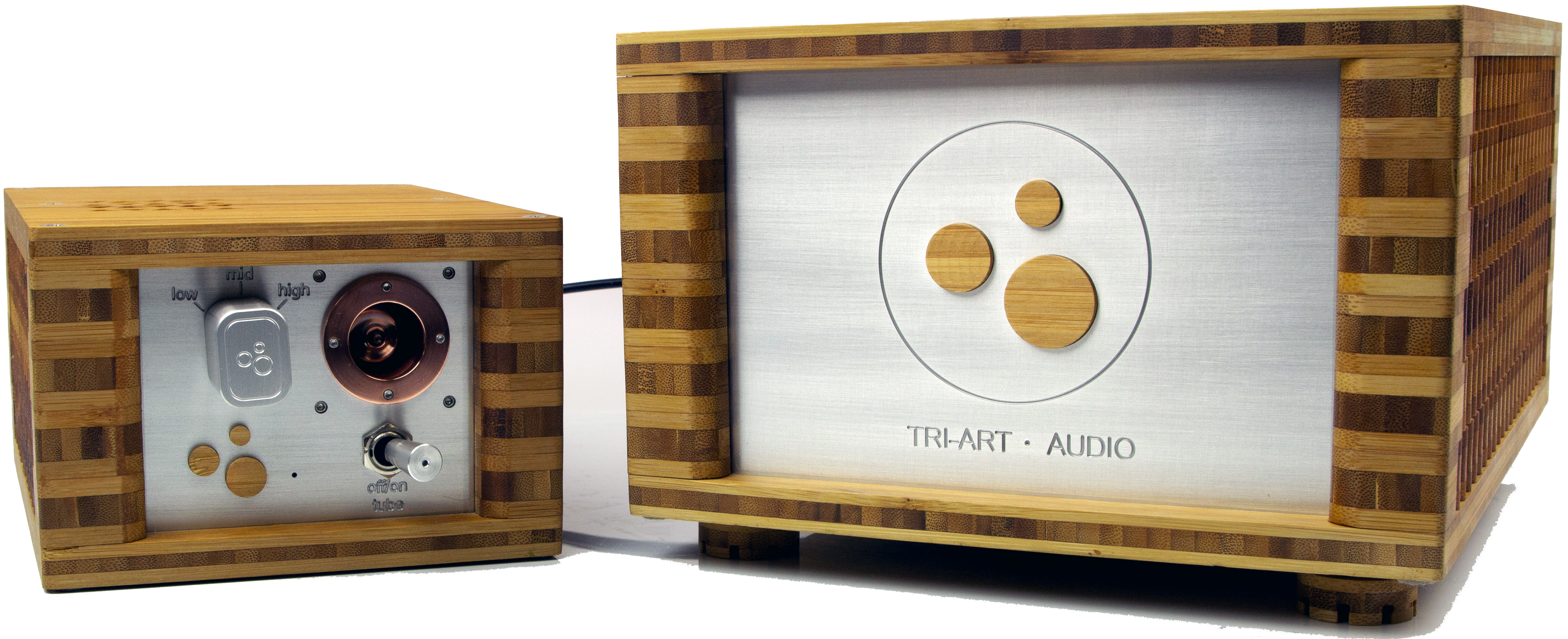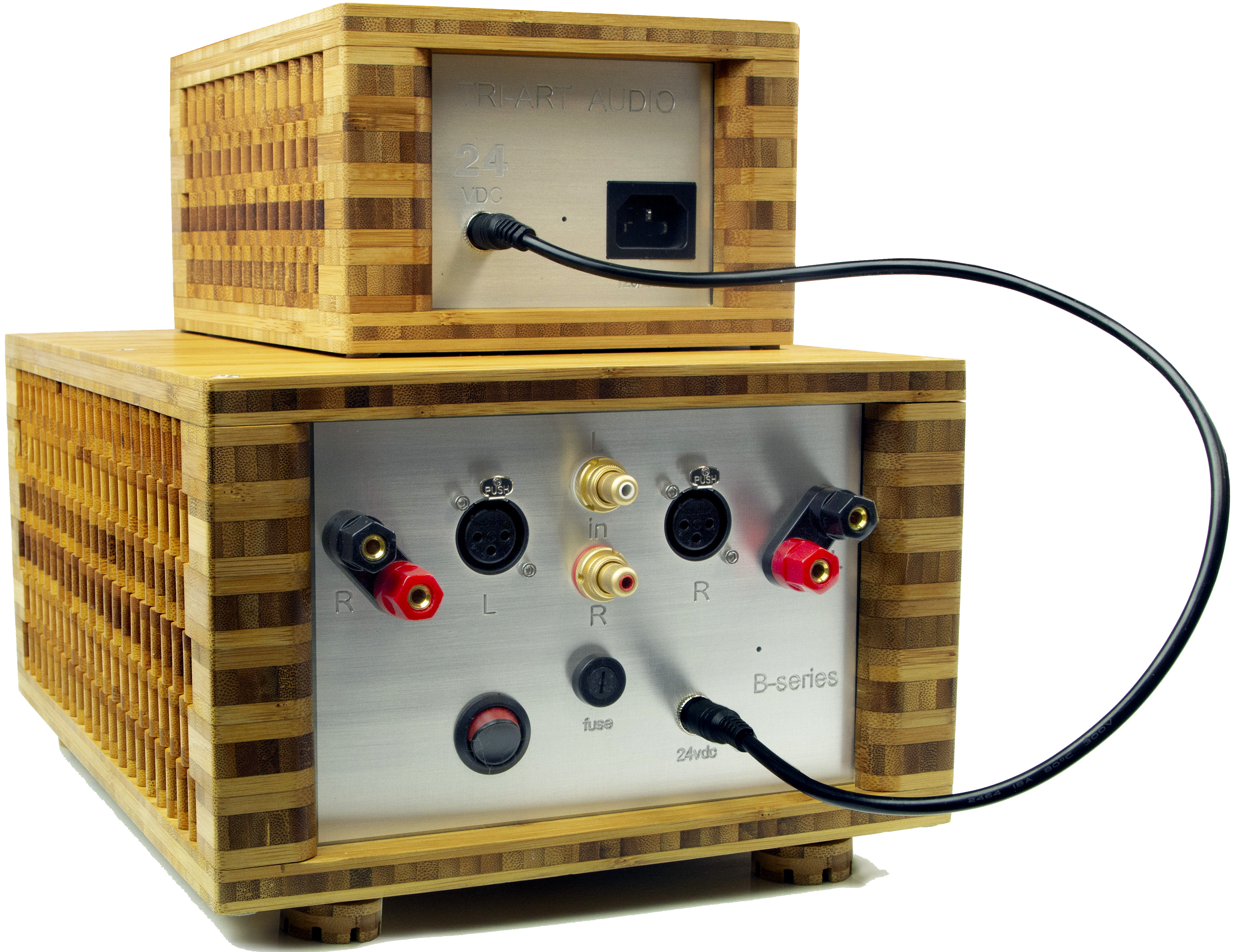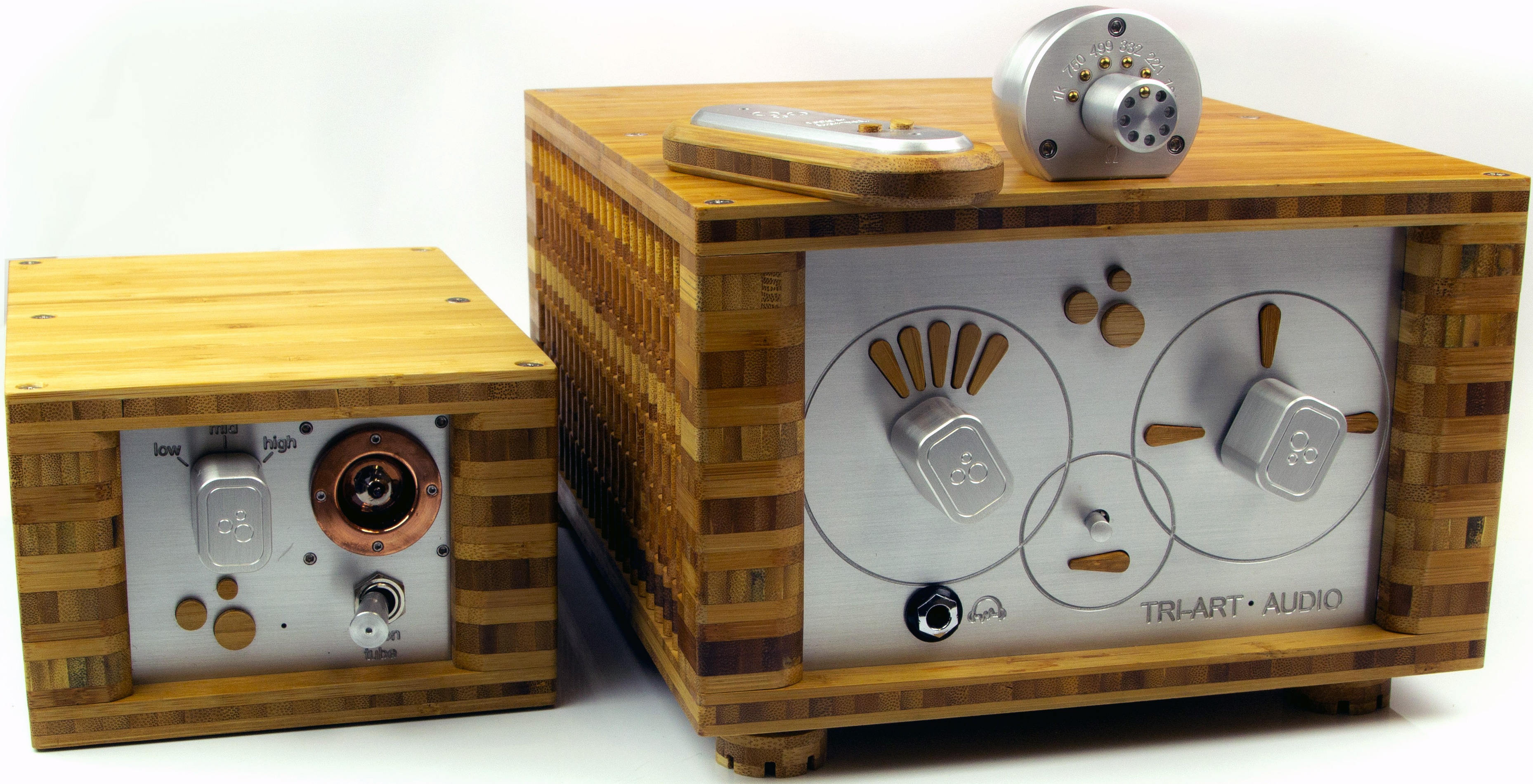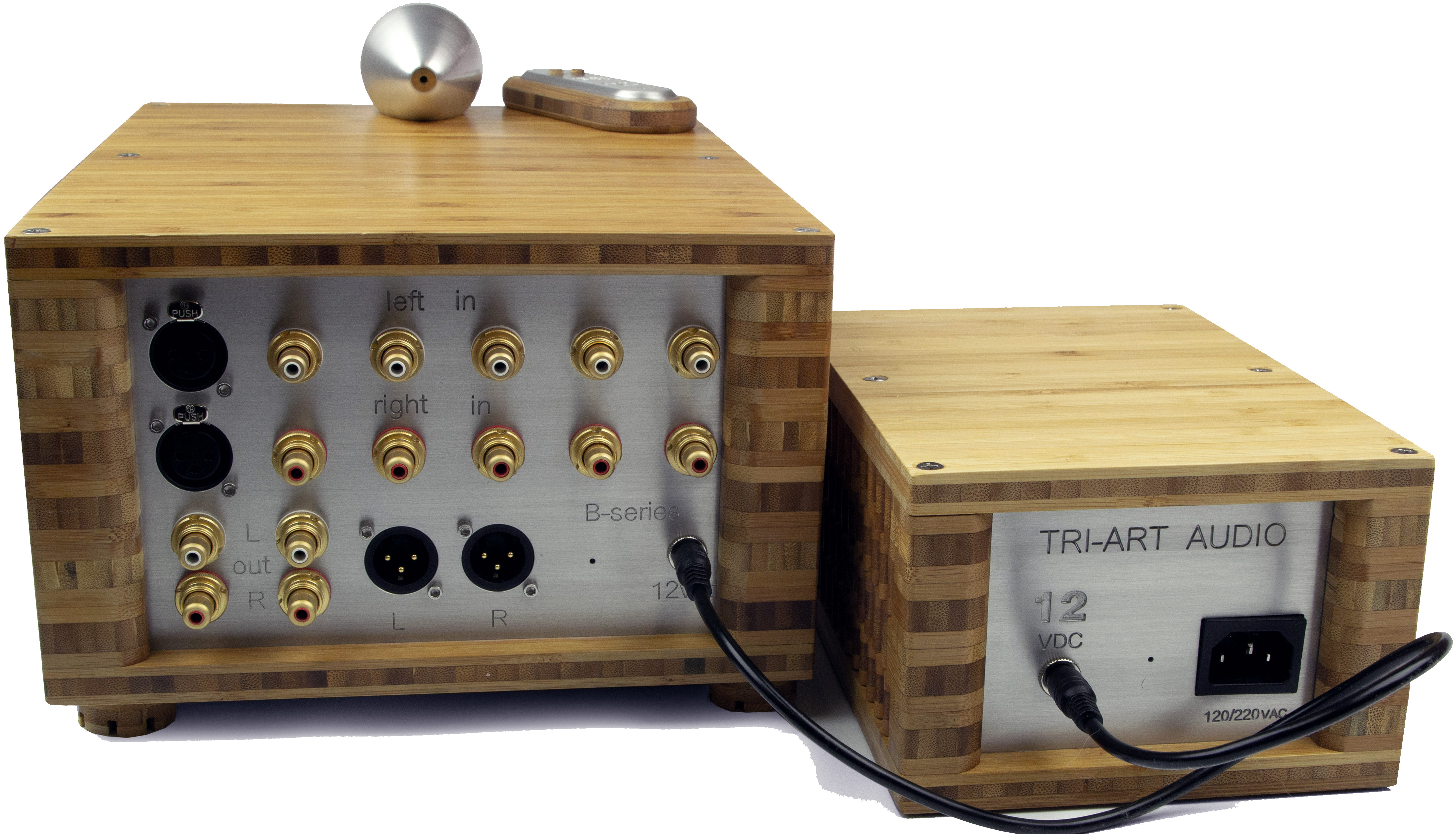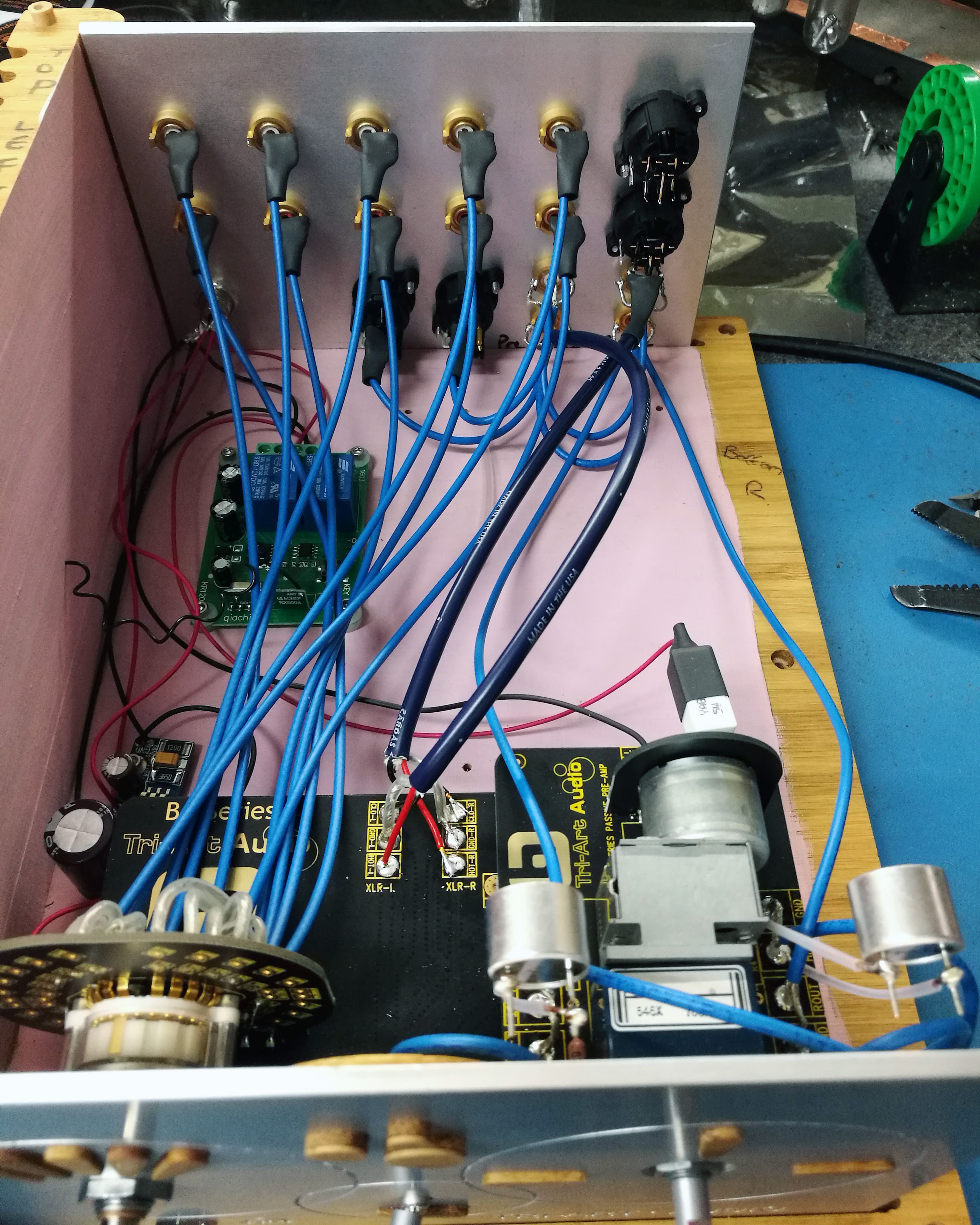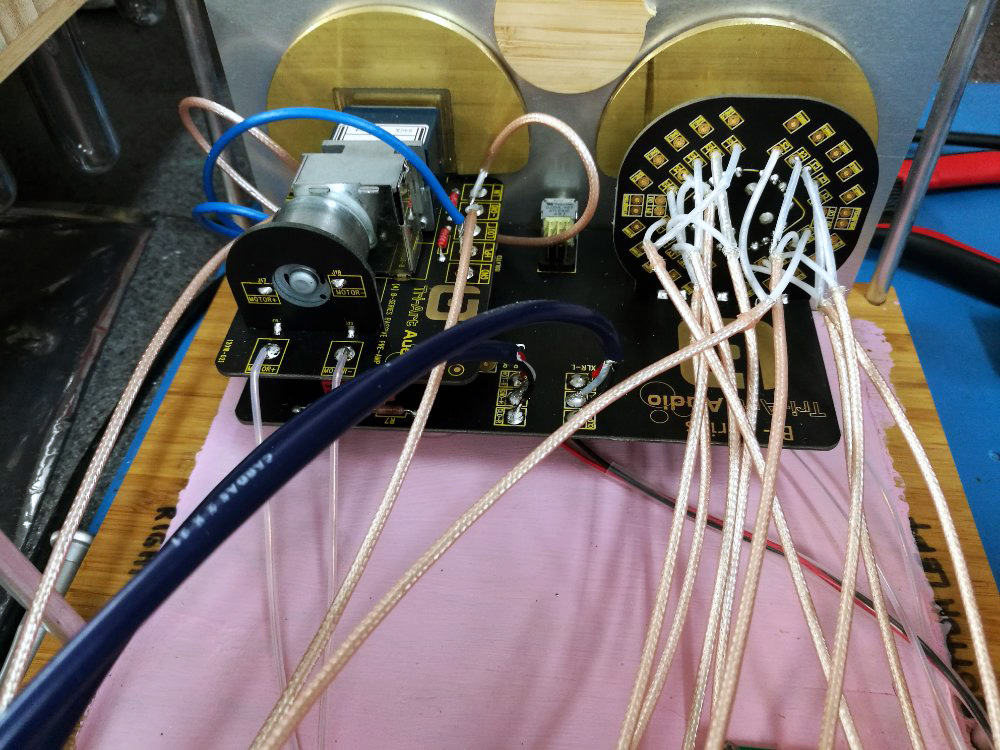Synergy
The synergy of this system is impressive! I have heard many one-brand systems, among them the (mostly) Tidal Audio system shown by Doug White from the dealership The Voice That Is. Such a system is many multiples costlier than the Tri-Art system. How could I possibly see parallels between two systems that are so different? They both have an extreme amount of system synergy. It is a similar synergy pursued by fans of SET (Single Ended Triode) amplifiers searching for the perfect high efficiency speaker. My friend, Dave, runs a pair of Volti Alura Speakers and followed manufacturer guidance by using the Border Patrol amps demoed at AXPONA because they sound great together. The big difference in this review is that Tri-Art makes everything. Look at the product catalogue and you will see the breadth of this company’s work. Surely that will ruin a one brand system, right? Not in this case. In the decades I have been in audio, and the 13 years reviewing, I have not encountered anything quite like Tri-Art. Literally, it’s a brand that makes a quirky, but high-performance sounding line of gear for a relative pittance.
Not an insignificant aspect of the synergy of Tri-Art components is the tube Gain feature. The term “Gain” is a misnomer, as Steve states: “Well, sometimes we use ‘gain’ to not actually mean volume gain. For example, on the tube buffered Power Supply, the GAIN switch is actually simply allowing more of the tube to be used. The tube light increases as you move the switch to the next level. It is not actually increasing the gain…”
It does definitely increase or decrease the warmth, and to a degree the resolution. It might be considered a “tube involvement switch” that allows the owner to ramp up or ramp down the amount of tube-like effect system wide. It acts as a multiple setting tube buffer, and when several of them are used in combination (i.e. Power Bar, Preamplifier and Amplifier) the permutations increase. On a component level, these offer an experience similar to the discrete opamp rolling I have done in Eastern Electric DACs and the recently reviewed Kinki Studio EX-M1+ Integrated Amplifier.
Tri-Art did not feed me the phrase “high performance” to describe their system. If there was ever a system that looked lifestyle yet attained high performance, the Series B equipment from Tri-Art is it. Pull up an image of Tri-Art Audio at AXPONA 2019 and witness those little bamboo boxes piled on one another! That brings up another question — how many umbilical cables does this system take? (Answer: three for the complete Series B digital source system and two for the system I reviewed.) Appearances can be deceiving, though, as we seasoned audiophiles should know. To the degree the Tri-Art system may look a bit off, its performance can be tuned to be dead on.
Step aside with me for a moment and let’s listen to some of the heavenly vocals of Eva Cassidy. Widely regarded as one of the most angelic Folk and Jazz singers of this era, Eva could sing the content of a technical manual and it would sound enchanting. I have used her vocals faithfully with nearly every system I have established in the past ten years. Her live recordings are excellent to assess a system’s capacity to render the recording space.
Part of the special sauce of the 5 Open is the ambient information provided by the dual 15” woofers. Along with the generous enough 8” full range, Eva’s voice is stress-free. Deep reaching acoustic reverberations fill the background as she sings one of her favorite songs, “People Get Ready,” on Live at Blues Alley. The interplay of her vocals with the guitars entwine and create a vibrant tapestry. In this sample, the 5 Open accomplishes the low-end presence of a very large dynamic speaker, and the tautness of a panel speaker.
Speaking of appearances and operations
Do not come away with the idea that I despise the appearance of the Tri-Art rig; like bamboo, it has grown on me. At first, I reviewed it despite the bamboo, but as I continue to use it, I like it more. It is a warm appearance, unlike most contemporary components. If the bamboo was formed from an aluminum billet the speaker would be cold looking and far more expensive, but the warmth of the material compensates for the starkness of design. The brushed aluminum faceplates of the components are diminutive enough that they do not overwhelm the thick bamboo casework.
The speaker’s body evokes thoughts of ergonomic design principles, as the perpendicular spine to the baffle carries the binding posts, “internal” wiring, and a capacitor for the tweeters. Holes of various sizes prevent wave reflections from the drivers, and unobtrusive footers with integrated adjustable spikes are just wide enough to stabilize the speaker, even on my thick Berber carpeting with generous padding.
This is not a speaker to have in a living space with junior crawling about, pulling on things. Early on in our marriage, in our naivety, my wife and I bought George Kovacs torchier floor lamps with tall, thin stems and frosted glass rims akin to a 2-meter martini glass. I loved the sleek, tidy appearance of those lamps, and our boys as toddlers loved the effect of shaking them! It’s not so impressive when your artsy floor lamps lean due to loosening. Similarly, especially given child safety concerns, this is a speaker that needs to be anchored heavily in the presence of children, or used in a child-free environment. Perhaps a weightier pedestal is something to consider.
The components are a study in contemporary manufacturing. The bamboo boxes are subtly art pieces themselves, especially with the integrated diffraction panel sides. Retro-modern, minimalist controls adorn the façade; functions are not obviously indicated, but require familiarity with the Owner’s Manual. The inlaid bamboo indicators for some switches are a nice flair. The forward-facing tubes ensconced in the copper ringed tunnels carry a 1950’s feel. All Tri-Art products are finished at a very high-quality level. The smoothness of the bamboo edges and the scalloping and ribbed portions of components are premium. The cables, while attractive, are more economically built, as is evidenced by the jackets over terminations being loose, so as to slip a bit with use.
Tri-Art is hitting a price point with its products, and slip on jackets on the wiring is a way to do so while emphasizing the geometry, conductors, and reliable terminations. Speaking of connections, the RCA posts on the back of the components are perhaps the most overbuilt parts, and are tighter than many others I have used, such that the cables do not slip on and off easily. Take care lest you pull too hard upon removing a cable and end up damaging it. I suggest you grip it firmly at the connection and twist slowly while pulling. In most respects, given that Tri-Art is making its appeal to the affordable sector of audiophilia, inspection shows high quality manufacturing equipment has been used to cut, sand and finish Tri-Art Audio products. You may dislike the appearance or philosophy of Tri-Art, but you may not disdain the commitment to a well-finished product.
Developed with ample resources
The extraordinary never arises from a vacuum.
As a matter of disambiguation, one of the most irritating aspects of contemporary conversation is chronic misuse of the term (or variants thereof) “evolve” as a substitute for what is obviously developed. Modern man has drunk the Materialist cool aid, and does not even wince when humanly designed products are advertised as evolving. Manufacturers seem clueless that they diminish their genius by use of the word evolve in advertisements.
Nothing of high precision evolves, ever. Lab work in the past twenty years on the biomolecular level has shown definitively that natural selection is par excellence at breaking biological structures, and cannot progressively build them. Conversely, the Intelligent Design Theory (or I.D.), of which I am a proponent, properly credits design when it is inferred, something that we do naturally. Those who would like a reading list of works by credentialed scientists who write about I.D. can contact me.
How does this relate to Tri-Art Audio? As creatures are not built from chaos, so also audio systems do not pop out of nowhere. One of the myths of audio manufacturing and DIY (do-it-yourself) audio is that the little guy with marginal talent will miraculously develop in his garage something with sound comparable to a show-stopping system. Supposedly, the budget builder will trounce the big boys at their game. No, that will not happen. Perhaps through years of slaving over a design or methodology a new product will come to the fore, but the spontaneous generation of a killer component or system by some hack without the means is not going to happen any more than a potpourri of amino acids will assemble itself into a cell!
Upon encountering the Tri-Art system my background in I.D. led me to realize immediately that the Series B is no fluke. It is not the product of an accident, not some lame design that evolved or came about via a shoestring budget. It didn’t come out of some pop-up component shop. It is the development, the outgrowth, of decades of experience and has emerged from a strong company with the resources to back the inspiration of Steve Ginsberg, one of the family owners of Tri-Art.
The components and speakers shipped from the Kingston factory bear the phrase, “Tri-Art family of products.” The blood of Tri-Art Mfg. is paint, but audio stirs Steve’s soul. Inquiring into his background, I was not surprised to learn that Steve has extensive experience in the audio sector. Back in 1978 he worked for House of Sounds in Kingston, Ontario, as an assistant to the repair technician, and later was a salesman. Ultimately, he opened up his own store, The Sound Room. He began making turntables and modifying speakers and amps. His education was in the Fine Arts, and that led him into business supplying materials to artists, the back bone of Tri-Art. Along the way an optical paint was developed and it became the basis for one division, called Goo Systems.
As there was an overlap at trade shows between the optical paint and the AV components, Steve was brought more directly into the orbit of HiFi. Meanwhile, he was using bamboo substrates in his artistic paint business, so he began to experiment with bamboo objects as isolation devices for audio. Already having millwrights in the plant for bamboo products, Steve was able to transition smoothly into production of casework for envisioned audio components.
Consider the backing necessary to employ 12 of over 80 employees at Tri-Art as full-time personnel in the audio division. Among them are Jim Leveille, Sales and Marketing Manager, Mechanical Team Leader Jim Brown, CNC Blueprint Design Leader Billy Day, and of special interest to me, Circuit Board Design/Electrical Leader Adam Thomaes, who is described by Steve as having come “from the Radio industry… very talented in both circuit design and trouble shooting.” Indeed, there is some special development happening in the circuits in these affordable components!
Now it is clearly seen why those who dismissed the Tri-Art room at AXPONA rushed to judgment. In a classic example of judging the speaker by the appearance, they dismissed decades of experience and substantial backing that stands behind the Tri-Art system. There are dollars and brains behind this effort. Oftentimes, first production products from audio micro manufacturers are pretty rough. I have tried occasionally to assist such manufacturers by highlighting their products with a review when I feel they have excellent sound quality. A few times I have been burned because I recommend a product but the manufacturer drops the ball in terms of customer service and/or the company fails. While no company is too big to fail, Tri-Art is a long way from a shoestring operation, and Steve Ginsberg and crew are far from business and manufacturing novices.
Little bamboo boxes and skinny wires
I spent time with three of the bamboo components; the P-Series Power Bar (the only P-Series component reviewed), and the B-Series Passive Pre-Amplifier and 60-Watt Amplifier. As will be seen below, all had direct influence of a tube employing an adjustable Gain switch. The Power Bar is statuesque, with a presence belying its $630 price tag. In terms of performance, like all other power bars I have used, it had both a positive and negative influence upon the system. Here I am careful to remind the reader that this is not a negative assessment of the Power Bar, as it performed as admirably as others I have used, but that the outcome of both positive and negative effects is what I have found in all system power treatment devices.
The positive effect of the Power Bar was the ability to contour system tonality holistically via the Gain adjustment’s three settings. Whereas most power bars give one result, along with the Pre-Amplifier and Amplifier, I could shift the system’s warmth and definition entirely. In what might be considered fine tuning, I could adjust the other components similarly. The negative effect was a universal weakness of such devices; it slightly diminished definition and current delivery to the components. I encourage potential customers to consider the Power Bar’s ability to multiply outlets as well as warm up a system via the tube GAIN control. If a paucity of outlets demands the use of a power bar, the Tri-Art Power Bar performs with as much ability as others, and adds a valuable tonal control.
I quickly came to cherish what I consider the centerpieces of the Tri-Art components, the Pre-Amplifier and 60-Watt Amplifier. These also have their optional companion Linear Tube Buffer Power Supplies with 3-position Gain settings. I will discuss these components more below.
The Tri-Art Power Cable (1.5m 13AWG) performed on a par with other similarly designed and made power cables. I thought the result of using them was not unlike the Anticables power cords, and the attractive price of the Tri-Art Power Cable makes it an acceptable choice for budget-conscious systems. My reference Clarity Cable Vortex power cord was richer and tonally denser, as well as yielding more clean low frequency extension. This is not a condemnation of the Tri-Art Power Cord, as all Tri-Art products are aimed at the lower end of the price spectrum. The Tri-Art Power Cords had excellent build quality and held firmly in place, with average flexibility.
Tri-Art shows its artistry in the 3m pair of Speaker Cables, which, again, performed in line with the Anticables Level 3.1 Speaker Wires. I have high sensitivity to high gauge speaker cables and interconnects, and strongly prefer lower AWG cables in all locations. There are enough ugly speaker cables, and Tri-Art’s colorful cotton snakeskin diamond patterned dielectric cable with bamboo plugs and gold-plated banana connectors is a sight for sore eyes. The integrated round bamboo spacers are a nice touch; however, they would impede threading these cables in tight spaces. The conductor with dielectric reminds me of the plain Bell Wire cables with white cotton dielectric I tried many years ago, which I left behind for much thicker conductors. This is a subjective preference, and a goodly portion of the audiophile community strongly prefer a thinner conductor. As such I did not find the sound of the Tri-Art Speaker Cables offensive, and if you have no proclivity toward judging such things, they will yield acceptable sound quality. To advance in this respect will likely cause you to spend more than you might find justifiable.
- ← Previous page
- (Page 2 of 4)
- Next page →

